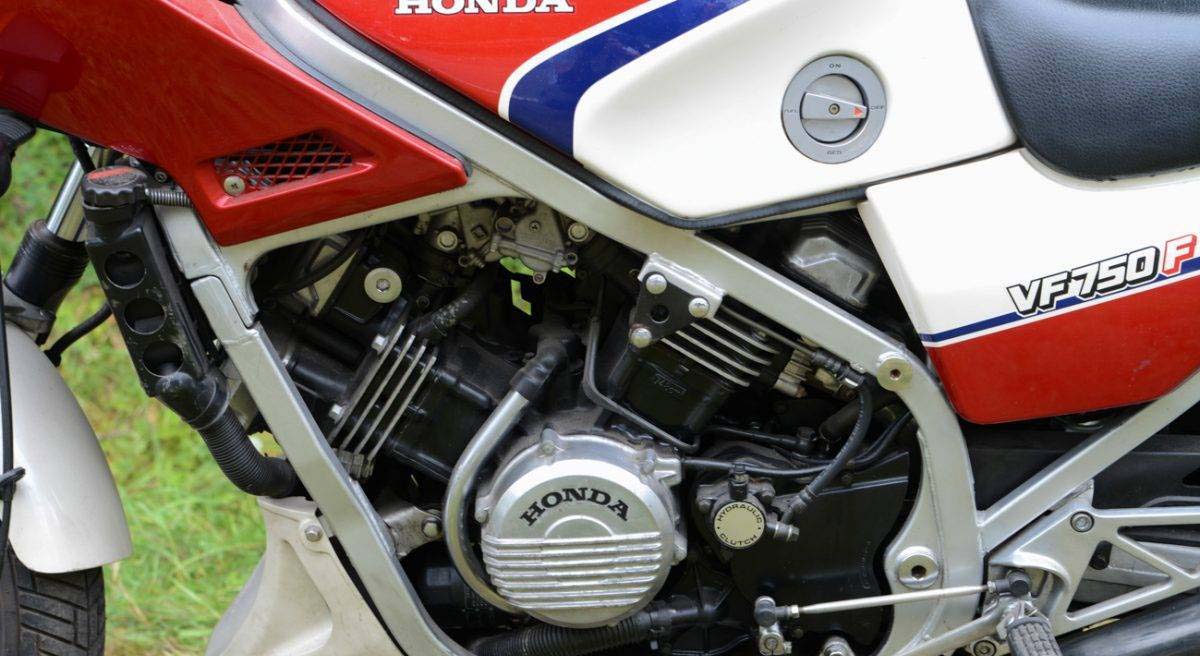
|
|
|
|
|
|
Classic Bikes
Custom Bikes
Individual
Racing Bikes AJP
AJS
Aprilia
Ariel
Avinton / Wakan
Bajaj
Benelli
Beta
Bimota
BMW
Brough Superior
BRP Cam-Am
BSA
Buell / EBR
Bultaco
Cagiva
Campagna
CCM
CF Moto
Combat Motors
Derbi
Deus
Ducati
Excelsior
GASGAS
Ghezzi Brian
Gilera
GIMA
Harley Davidson
Hero
Highland
Honda
Horex
Husaberg
Husqvarna
Hyosung
Indian
Jawa
Kawasaki
KTM
KYMCO
Laverda
Lazareth
Magni
Maico
Mash
Matchless
Mondial
Moto Guzzi
Moto Morini
MV Agusta
MZ / MuZ
NCR
Norton
NSU
Paton
Peugeot
Piaggio
Revival Cycles
Roland Sands
Royal Enfield
Sachs
Sherco
Sunbeam
Suzuki
SWM
SYM
Triumph
TVS
Ural
Velocette
Vespa
Victory
Vincent
VOR
Voxan
Vyrus
Walt Siegl
Walz
Wrenchmonkees
Wunderlich
XTR / Radical
Yamaha
Zero
Video
Technical
Complete Manufacturer List
|
Honda VF 750F Interceptor V45
It was the first sportbike born with racing DNA. Years ago, you either rode an Interceptor or you were way behind. There were two kinds of sportbike riders in 1983. Those who owned a VF750 Interceptor, and those who lusted after one. Armed with newly developed Honda Grand Prix technology, such as a track-inspired fairing, 16-inch front wheel, rectangular-section perimeter frame, single-shock rear suspension and anti-dive front suspension, the Interceptor was a back-road rapier among pocket knives. Power was cutting edge. As the first liquid-cooled engine in any sportbike, the Interceptor's 90-degree V-four spun out an amazing 86 horsepower, making the bike quicker in the quarter mile and faster on top than its peers. In a top-gear roll-on, the Interceptor flat crushed them, and, in so doing, exploded the notion that high-performance sportbikes had to have narrow powerbands crowded close to the redline. Those triple-disc brakes were regarded as the best brakes on any mass-produced street bike. When the pavement turned twisty, nothing else measured up. And if you felt like crossing a time zone or two, the Interceptor was versatile, smooth and comfortable enough for the job.
That original Interceptor, through its racing and sales success, proved that Honda's integrated design approach worked as well on the track as it did on the street. Fast, agile, comfortable, perfectly balanced, the Interceptor began a Honda design philosophy that created a line of sportbikes with tremendous performance and street civility, a line leading straight to the aluminum-frame, fuel-injected 800 Interceptor in Honda's 2000 lineup. Even if you weren't old enough or lucky enough to experience the Interceptor in 1983, the magic lives on in Honda's sportbike line, and it's better than ever.
Debut in U.S. and world markets: 16" front wheel, 18" rear wheel, silver alloy painted Steel Perimeter (Twin Spar) frame (Similar to GSXR or Honda NS500 frame), Single rear shock w/ 2 sided Alloy swingarm, 1/2 upper fairing with chin or belly fairing, 360x crank, chain driven cams, 4/2 exhaust system with a HUGE, overweight collector box in the middle. The forks had TRAC mechanical anti-dive mechanisms. One cool feature was the fuel petcock which was built into the left side of the tank. Colors were white w/red stripes and white w/blue stripes (U.S. models). Canada/Europe got combos of the colors (i.e. mostly blue with the small red strip instead of same color blue stripe or red w/ blue stripe). American models were outfitted with cast rims while European models received bolt together "Comstar" wheels that featured large "plates" drilled with holes, attaching the hubs to the rims. They were gold anodized.

|
|
|
Any corrections or more information on these motorcycles will be kindly appreciated. |